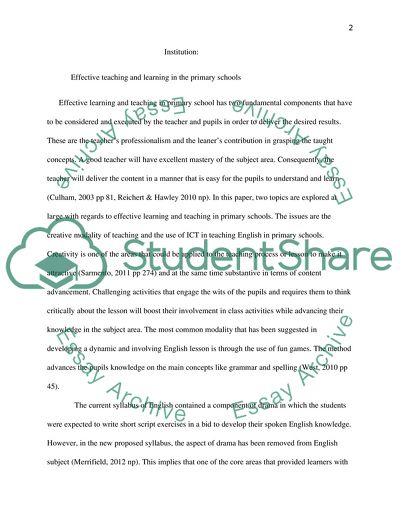Cite this document
(Effective Teaching and Learning in the Primary Schools Literature review Example | Topics and Well Written Essays - 2750 words - 1, n.d.)
Effective Teaching and Learning in the Primary Schools Literature review Example | Topics and Well Written Essays - 2750 words - 1. https://studentshare.org/education/1852657-identify-key-features-of-effective-teaching-and-learning-in-the-primary-school-critically-reflect-upon-one-of-these-key-features-and-justify-your-selection-include-references-to-recent-research-and-experiences-in-school
Effective Teaching and Learning in the Primary Schools Literature review Example | Topics and Well Written Essays - 2750 words - 1. https://studentshare.org/education/1852657-identify-key-features-of-effective-teaching-and-learning-in-the-primary-school-critically-reflect-upon-one-of-these-key-features-and-justify-your-selection-include-references-to-recent-research-and-experiences-in-school
(Effective Teaching and Learning in the Primary Schools Literature Review Example | Topics and Well Written Essays - 2750 Words - 1)
Effective Teaching and Learning in the Primary Schools Literature Review Example | Topics and Well Written Essays - 2750 Words - 1. https://studentshare.org/education/1852657-identify-key-features-of-effective-teaching-and-learning-in-the-primary-school-critically-reflect-upon-one-of-these-key-features-and-justify-your-selection-include-references-to-recent-research-and-experiences-in-school.
Effective Teaching and Learning in the Primary Schools Literature Review Example | Topics and Well Written Essays - 2750 Words - 1. https://studentshare.org/education/1852657-identify-key-features-of-effective-teaching-and-learning-in-the-primary-school-critically-reflect-upon-one-of-these-key-features-and-justify-your-selection-include-references-to-recent-research-and-experiences-in-school.
“Effective Teaching and Learning in the Primary Schools Literature Review Example | Topics and Well Written Essays - 2750 Words - 1”. https://studentshare.org/education/1852657-identify-key-features-of-effective-teaching-and-learning-in-the-primary-school-critically-reflect-upon-one-of-these-key-features-and-justify-your-selection-include-references-to-recent-research-and-experiences-in-school.


